Experience Authentic India – Shakti Village Walk
Shakti Village Walk
In every destination there are different ways for travelers to connect with the local culture. In Italy, we rented a villa and befriended our neighbors. On an Island in French Polynesia, we drove to untouristy areas and ate in local cafes. In India, in the hopes of seeing a part of the country unaffected by tourism, we booked a Shakti Village Walk.
I was certain the Shakti Village Walk would be better than my first trip to India – a blur of all the mosques, tombs, forts, and temples that all novices feel compelled to visit. I did better the second time around when I searched for the country’s traditional side. Then, I learned about Ayurveda and yoga, took a short (and life-changing) course in Vedanta philosophy, and visited an ashram where saffron-robed devotees chanted and set glowing candles afloat on the Ganges. After those two trips, I felt I was “finished” exploring Indian culture.
Then I met Jamshyd Sethna, owner of Banyan Tours and creator of the Shakti Village Walk program. At an event in L.A., I listened while he rhapsodized about the beauty of experiencing village life in the foothills of the Himalayas. “You haven’t been to India if you haven’t walked through at least a few of her many thousands of rural villages where life goes on pretty much the way it has forever,” Jamshyd told me. That night I realized I still hadn’t connected with the heart of India and started planning my next trip.
I already knew that India is more than call centers and big cities, but I had no idea how important agriculture is to this country until my husband and I walked (and drove) between villages in the Kumaon district many hours northeast of Delhi. Jamshyd has made this excursion very do-able for overseas visitors by assembling a superb staff of Shakti Village Walk guides, drivers, cooks, and hosts and renovating and building houses that are a day’s walk apart.
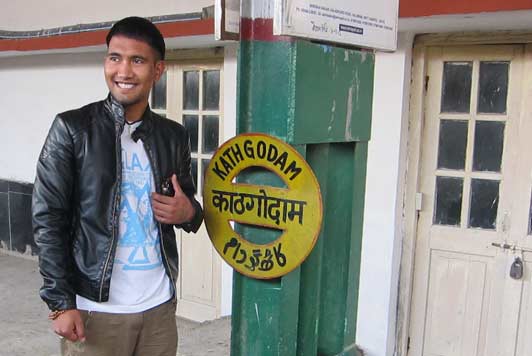
Our guide Stanzin Thinless picked us up at the train station in Kathgodam. We opted for the daytime train, although another one operates overnight. From Delhi to Kathgodam is a 5 ½ hour trip.
Our Shakti Village Walk allowed us the rare opportunity to stay in villages untouched by tourism and witness the daily life of the people who live there. “Our” houses looked like all the others on the outside, but inside they offered bathrooms with Western-style plumbing and solar hot water, comfortable king beds with down comforters and pashmina blankets, attractive furnishings, and – in most cases – a wood stove and electricity. Every morning started with “bed tea” delivered by the house host, followed by a delicious breakfast served al fresco with a valley or mountain view. Then, with the luggage loaded in a waiting car, we’d set out on foot with our guide Stanzin Thinless – a virtual encyclopedia of information on local plants, animals, geology, and customs.
We carried daypacks for cameras, sunscreen, and extra layers of clothing; elegant picnic lunches were provided by the Shakti Village Walk staff. “Our” houses were about 9 miles apart, but we walked at altitudes up to 8,000 feet, so I was glad I’d brought hiking poles from home. Previous Shakti clients include a German couple with a 5 year old child and a 79 year old solo Australian woman. Just the same, I felt better knowing that a car was nearby when I got tired, and I appreciated that on Shakti Village Walks groups are never mixed. Every single, couple, or family has the undivided attention of a well-informed guide who is sensitive to the preferences of his clients.
In the forest we saw a few rhododendron trees with bright red flowers, but we were a couple of months early for their really spectacular blossom display. Instead, our flashes of color were the blue, orange, yellow, and fuchsia saris worn by every woman we encountered. Some of these were herding cows or goats into the forest to graze, others were walking along the road with huge bundles of firewood on their heads, and other were tending crops growing in steep terraces that had been cut into the hillsides. The big take-home message for me was that these villages are the backbone of the Indian economy and the strength of their society. Everyone works hard – and together – in traditional roles for mutual benefit. The people care for the animals and the land and, in turn, the land and the animals provide for them.
Government schools are free, and I loved watching flocks of kids in their crisp little uniforms laughing and playing on the way home. One highlight of the trip was stopping at a school and delivering supplies we’d brought from home.
360 Leti
In addition to creating the Shakti Village Walk program, Jamshyd also built 360 Leti, an exclusive retreat near the borders of Nepal and Tibet. This remote lodge is comprised of four stunning guest pavilions and a main lounge and dining room area – all with a breathtaking view of the Himalaya Mountain Range. Many guests – including us – combine a few days at luxurious Leti with three or more days between villages.
Walking trails start from the lodge, but I gave in to temptation and hung up my hiking shoes while we were there. Instead, I took a cooking lesson from chef Yeshi Lama, who stole my heart with his memorable meals. While we stirred and chopped, I learned that this talented Tibetan was a monk until age 26. I also studied the night sky and did a little yoga, but – honestly – what I will always remember about Leti is waking up to the view of the snow-white mountains and clear blue sky. Cuddled under my pashmina blanket, I gazed at the panorama through floor-to-ceiling, wall-to-wall windows long after the tea was cold. Outside nothing stirred and the only sound I heard was the distant voices of village children. I can’t think of a better way to connect with the heart of India.
Cheers,

P.S. On a personal note, as much as I love traveling in India, I think I should mention that it’s not unusual for visitors to experience “digestive upsets.” If you think that might happen to you, here are my suggestion for prevention and treatment.
Category: India, Walking vacations

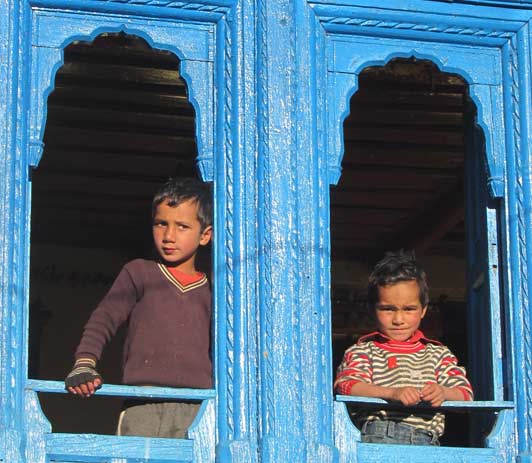
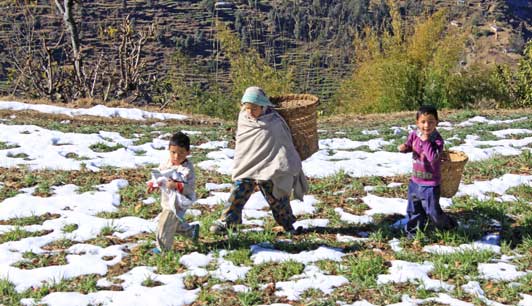
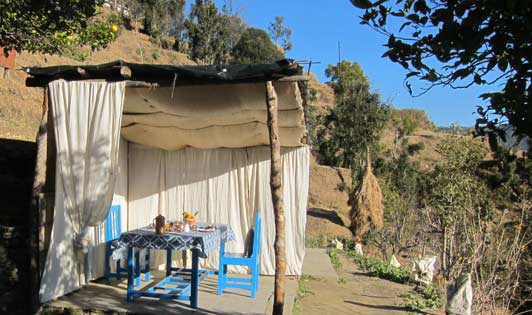
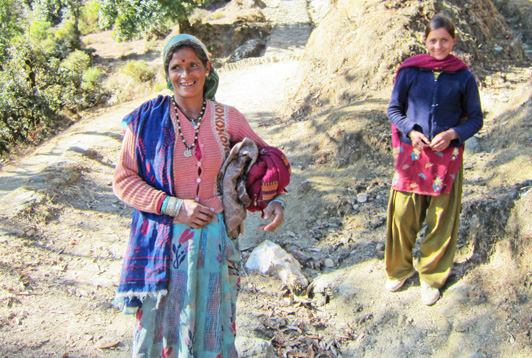
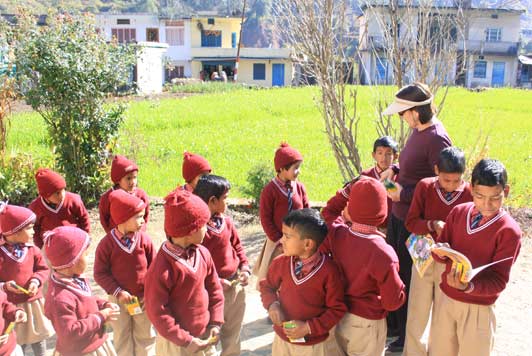
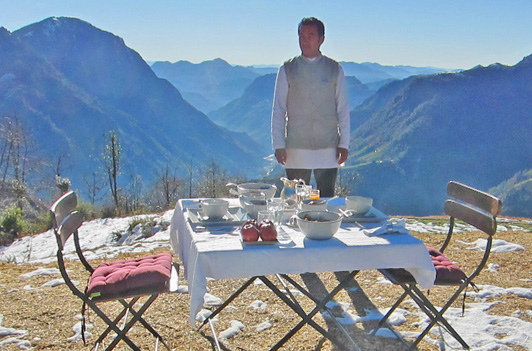
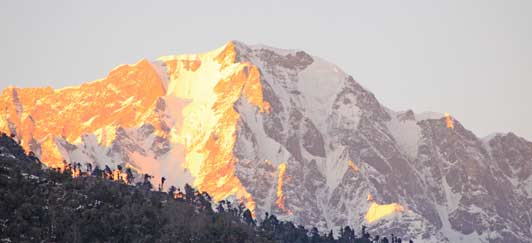









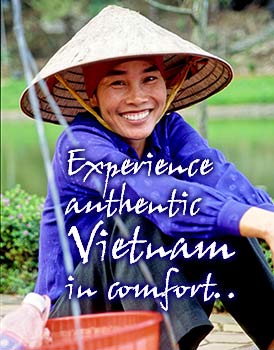



What a story! You really did connect with the soul of India on this trip by walking from village to village. And so nice that you had all the comforts of home too like a king-size bed).
It was an amazing experience. Just seeing the process of village life…women in colorful saris carrying huge bundles along the road and working in the fields, really cute kids skipping off to school in neat little uniforms, cows cared for like members of the family. Indian men seem to have in “made,”but I understand that a lot of them go in the military as a way of supporting their families, so that would even things out a bit.